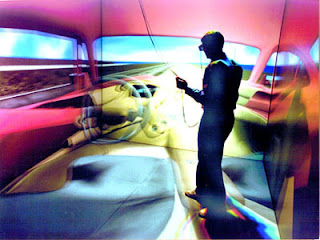Automatic Learning--It Came to Me in a Dream

Jeff Lieberman had a dream about ways of learning skillful physical movements without verbal coaching--pure tactile feedback. He went on to help develop a "haptics feedback suit" to study tactile learning. It is an intriguing idea.
MIT researchers Jeff Lieberman and Cynthia Breazeal have published the results of the study in a recent issue of IEEE Transactions on Robotics. The study presents a proof-of-concept wearable robotic system that provides real-time tactile feedback over every joint simultaneously.Physorg
“Oddly enough, the idea for the robot suit initially came from a dream,” Lieberman told PhysOrg.com. “The dream involved people who weren't physically able to express themselves, but who were mentally normal, who used a machine that aided them to get their inner feelings out. This ranged from people with muscular difficulties to even toddlers and 'untrained' people who do not know how to wield a paintbrush. Upon waking and thinking about that idea for about an hour, the idea for this project was born, and I started doing research that day; the overall project was about six months for software and hardware development.”
In experiments with arm motions, the researchers found that the suit increased students’ learning rates by up to 23%, and reduced errors by up to 27%, as well as enabling students to learn movements “more deeply” by affecting their subconscious learning of motor skills. The latter can be especially important for patients with neurological injuries who have lost the ability to form new long-term memories, but can still build new motor skills.
The suit works by optically tracking body markers for the teacher’s movement (or a pre-recorded ideal movement) and the student’s movement with a Vicon motion capture system, which has millimeter accuracy. The tracking data is fed to software that compares the teacher’s and student’s movements, and generates feedback signals to the suit.
Imaginative persons can easily think of many uses for such a tactile feedback learning system. A large part of the widespread incompetence in society comes from the lack of practical skills with the hands and body. A sedentary society--forced to sit inactive for one third of the day from childhood to young adulthood, spending countless hours sitting watching television, texting, chatting, playing video games, etc--learns inactivity early, and neglects the body and the skills the body is capable of exhibiting.
The part of the mind that deals with banal, everyday things, or with abstract ideas, is well exercised by most children, teenagers, and adults. The parts of the mind that guide the body in skilled activities that make life more enjoyable, more workable, or more prosperous, are generally neglected.
Traditionally, fathers taught sons physical/tactile skills, as mothers taught tactile skills to daughters. Modern parents often do not have the time or spend the time to teach children practical skills. Such teaching requires patience and energy that may be lacking--not to mention the required skills that parents may never have been taught themselves. Now, these skills can be taught from tutorials online or on disk.
But the learning opportunities from such tactile feedback suits extends far beyond practical skills of modern life's technologies. Surgeons in training could learn from the deft, precise movements of the best surgeons. Pilots would learn firm, timely responses to unexpected emergencies in simulators.
It is one thing to teach the mind a skill. It is quite another to teach the body. Modern education neglects the body. (it also neglects the mind, but that is another story)
A deeper meaning behind such training is the fact that much of the cognitive strength of the mind derives from being "embodied." Our verbal and pre-verbal conceptual languages rest upon metaphors of embodiment. The sensory feedback from the body, as interpreted through embodiment metaphors, drives much of our thinking. More on this later.
The MIT research discussed in the Physorg article above promises important advances in a field of research that is not exactly brand new. But qualitative improvements in a pre-existing field can make the field seem new again.
Tactile feedback may just hold the conceptual key that has been missing from stonewalled efforts in machine intelligence, cognitive enhancement, and ultimately brain emulation and downloading. Stay tuned.
Labels: central pattern generators, feedback, haptics, Virtual Reality





















